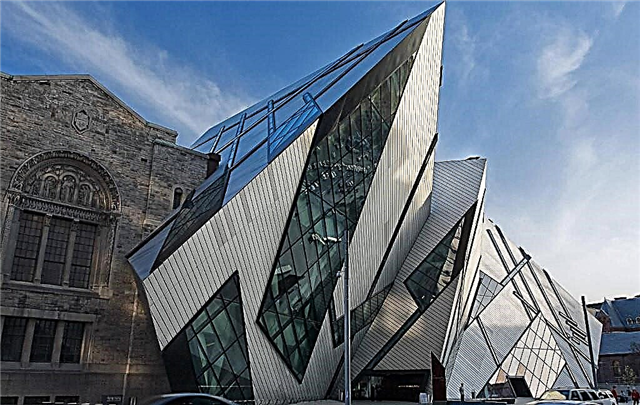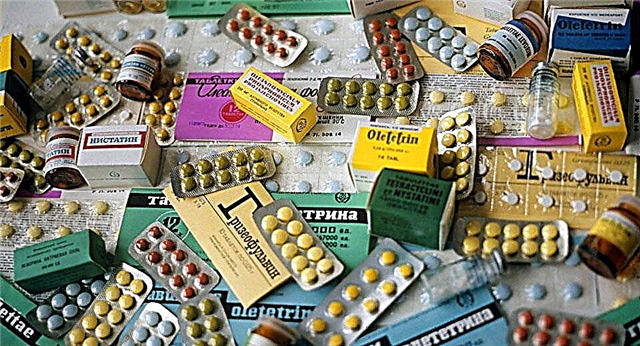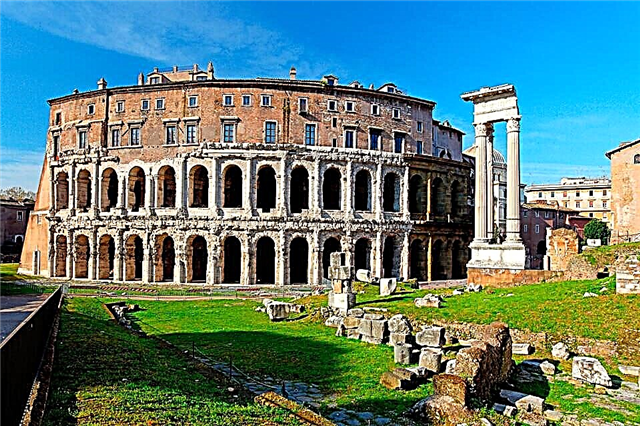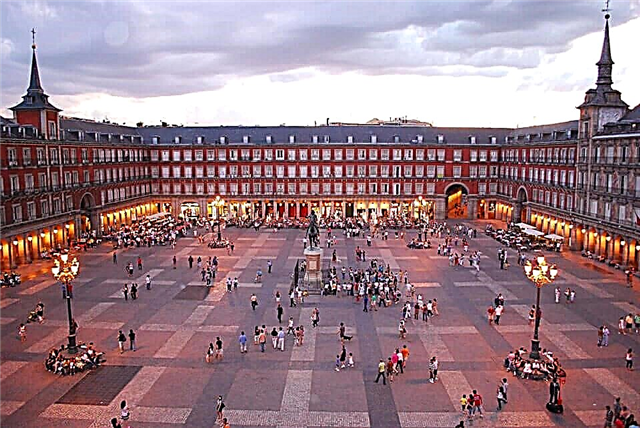Despite the fact that the Spanish capital is located 300 km from the sea, its original name "macherit" is associated with water. In Arabic, the word means "a source of full waters." The city, whose name in the Middle Ages began to be pronounced as "Madrid", really stands on strata rich in underground waters. The location of the city in the center of Spain was the main factor in assigning it the status of the capital of the state in 1561. After that, Madrid began to develop rapidly: construction of housing proceeded rapidly, Royal factories for the production of glass, porcelain and carpets were opened.
Today, a modern metropolis with a developed industry and infrastructure is an example of a progressive European city. Here, along with modern architectural structures, not only monuments of ancient architecture are carefully preserved, but also entire microdistricts with narrow streets and atmospheric courtyards. In terms of the number of unique attractions, Madrid is not much inferior to Barcelona.
The birthplace of the famous tenor Placido Domingo is beautiful for its gardens and parks, squares and palaces, museums and theaters. If, when visiting the city, you plan to do without an excursion, we offer you a recommendatory overview of what to see in Madrid in 1 day on your own. Read and make a selection of attractions from this review.
Arena Las Ventas
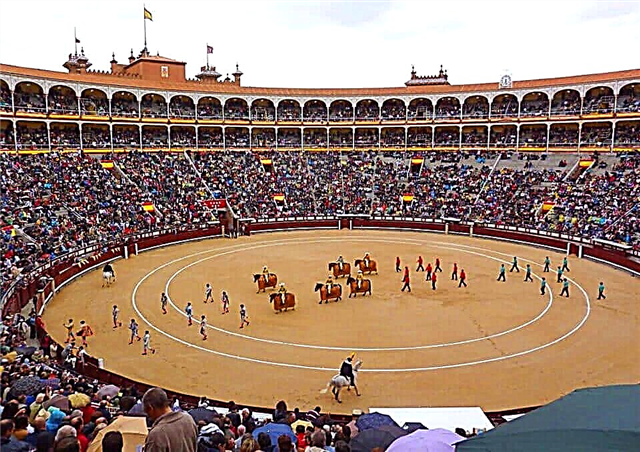
The symbol of national entertainment, embodying the courage of Spanish men, is the Las Ventas arena, an unusually beautiful architectural structure made of red brick. A monumental building in neo-Mudejar style, surrounding an open round area, was erected during the heyday of the art of fighting with bulls (20-30s of the last century). The first bullfighting season took place in Las Ventas in 1935, and then for 4 years the arena was empty due to with the civil war.
The majestic 4-level building, decorated with numerous arches, scalloped edging of walls, rectangular towers and spiers, cannot fail to impress with its appearance. The composer M. Lillo dedicated his musical work to this magnificent sight - Paso Doble. The arena seats 23,798 spectators. Bullfighting fans come here from March to October - during the bullfighting season. The rest of the time, other performances take place here.
Monuments to the dead bullfighters and the English scientist who invented penicillin, Fleming, are erected at the facades of the building as a sign of merit in saving the lives of the soldiers. In 1951, the Bullfighting Museum was opened here, where exhibits related to dangerous art are displayed. An authentic costume soaked in the blood of a matador makes a strong impression. Paintings and sculptures depict bold, courageous bull lords.
Retiro park
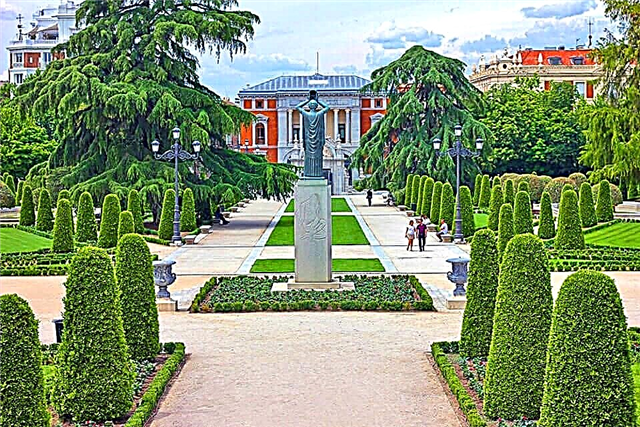
Even tourists, spoiled by the views of various parks, cannot hold back boundless admiration when they first find themselves in a huge landscape and architectural kingdom - the Retiro Park. The definition - “green lungs of cities” (more than 15 thousand trees) will definitely fit it. Just add to this metaphor that it is also an oasis of beauty, culture and sports. On 125 hectares among green areas, flower lawns, there are magnificent palaces, fountains, thematic gardens, ponds, sports and entertainment centers.
One cannot indifferently walk past the Velazquez Palace or the Crystal Palace, which today serve as exhibition pavilions. On the Big Pond, you can ride a boat or boat, sit on the shore under the spreading crowns, feed waterfowl. Graceful sculptures adorn the alleys of Retiro, among which the Fallen Angel is the only statue of the devil in the world.
It depicts the scene of the expulsion of Lucifer from paradise. The memorial dedicated to King Alfonso 12 is impressive to the depths of the soul. 20 best sculptors worked on the composition, consisting of a snow-white colonnade, a majestic pedestal with an equestrian statue on it and allegorical sculptures. Every visitor to the Retiro feels the fabulousness of this place.
Crystal palace
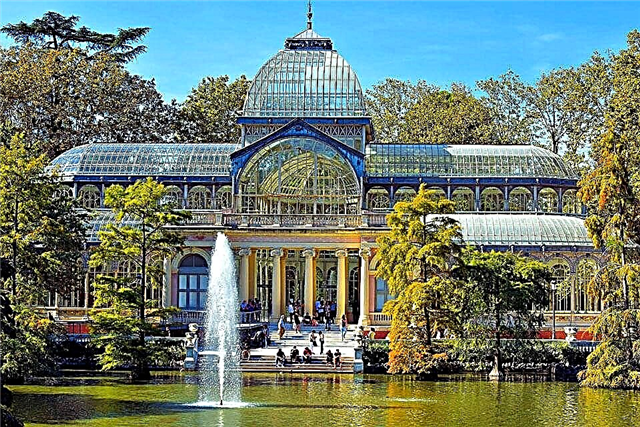
An amazingly beautiful airy building made of metal and glass - the Crystal Palace was erected in Retiro Park in 1887 to host an exhibition of tropical plants of the Philippines. The famous architect Velazquez decided to make an analogue of the London Glass Palace, located in Hyde Park. The brainchild of Velazquez partly surpassed Paxton's palace in graceful beauty and perfection of design.
Located at the very edge of the artificial lake, this architectural wonder is a mesmerizing sight. One gets the impression that the palace is on the water, and this makes it even more attractive. It was the first glass building built in Spain, and at that time it was a unique structure. But today it remains the most popular object for photography by enchanted tourists.
Intricate glass structures are mounted on a strong wrought iron base, on top of which is a brick and stone platform. It is faced with picturesque ceramic tiles created by the Spanish ceramic artist D. Zuloaga. The entrance is decorated with classic columns with a balustrade, and a giant dome crowns the roof. Glittering under the sun, the palace really seems to be crystal. It hosts various exhibitions, admission to the Crystal Palace is free.
Alcala gate
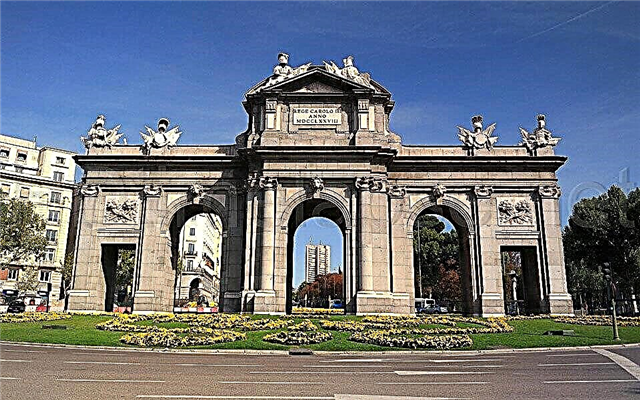
Next to the Ritero Park there is a monumental granite structure - the Alcalá Gate. This truly historic building was erected in 1778 at the main entrance to the city, and now you can see how the borders of Madrid have expanded. Alcala Gate today is a magnificent architectural monument of the 18th century. on the street Alcala. Although the street of the same name went aside after the reconstruction, its name stuck behind the gates that divided the street in half. The initiator of the construction of the new gate at that time was King Charles III, who actively sought to modernize the city.
It is impossible not to admire this granite 5-arch monument - the embodiment of grandeur, grandeur and beauty. The eastern facade is marked by 10 columns with capitals. The name of Charles and the date of construction are carved above the central arch on both sides, and above there is a sculptural image of mythological characters and children's figures. The side arches of the western façade are crowned with lion heads and cornucopia. Above each of them there are 2 sculptures - symbols of Virtues. The gates of Alcala are destined for eternity - they seem unshakable.
Cibeles Palace
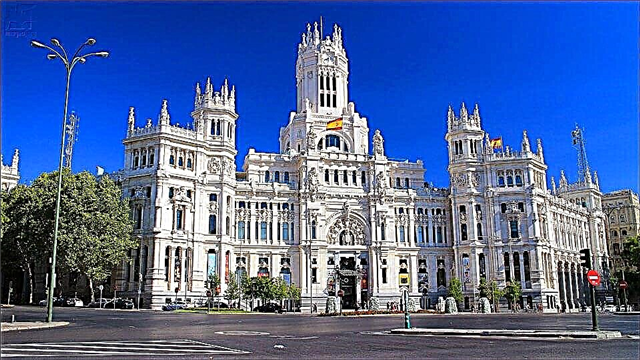
The fabulous-looking snow-white Cibeles Palace, located on the square of the same name, was under construction for 13 years (1904-18) And this is not surprising: the architecture of the huge structure is a complex of all kinds of turrets, columns, pinnacles, galleries, spiers and other pretentious elements in the style of "neochurrigueresco ". The most talented architects and engineers worked on the project of an amazing masterpiece, famous for the amazing result of their efforts. The inauguration of the Palace of Telecommunications took place in March 1919, and in 1993 it was included in the honorary list of cultural heritage sites in Spain.
After a large-scale restoration of the facades, the building of the palace, which was named Cibeles in 2009, is owned by the City Council. The townspeople lovingly call the main attraction of the square "wedding cake" - the palace is so delightful. On an area of more than 12 thousand square meters. m today there are various cultural and entertainment institutions: a reading room, public information sector, exhibition pavilions, concert halls, a restaurant.
Even a visual inspection of the magnificent structure leaves a deep impression. But a real miracle awaits you if you go inside and go up to the observation deck, equipped on the 7th floor.From here you will see a 360 ° panorama of modern Madrid. The boulevards of Castellana and Recolesos filled with vibrant life, Alcalá and Gran Vía streets, picturesque greenery of the Paseo del Prado alley will open before you - the center of the capital will amaze you with its various beauty.
Thyssen-Bornemisza Museum
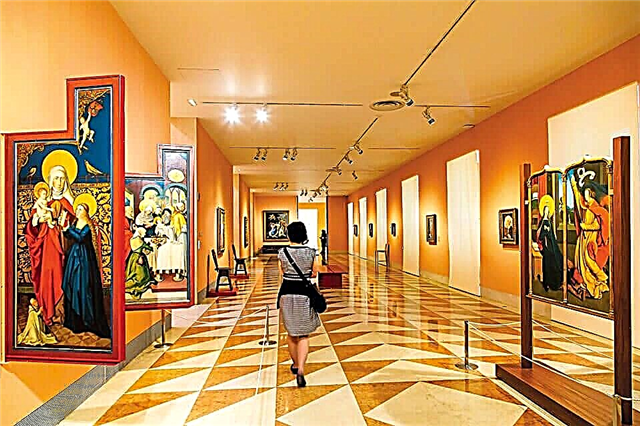
Do you want to plunge into the magical world of quality painting? Be sure to visit the Thyssen-Bornesima Museum, located in a small district, conventionally referred to as the "golden triangle of art." It is named so because of the concentration in this place of several large museums, including the famous Prado. The founders of the institution are the father and son of Thyssen, who were awarded the title of the Hungarian Baron Bornemisza, owners of a huge collection of paintings painted over 8 centuries by various artists.
The purpose-built building houses 4 museum exhibitions reflecting the chronology and trends of the art of world painting. The largest collection (1st exposition) presents works by Italian, Dutch, Flemish masters of the 13-16th century. Among them there are absolute rarities - the canvases of Lucas-Cranach (father), Memling and Holbein. The second exposition contains works by artists of the Renaissance, Baroque and Rococo (17th-18th centuries).
Here you can admire Titian's Madonna, Rembrandt's Self-portrait, paintings by Rubens, Tintoretto, Gainsborough and other brilliant creators of the brush of these directions. The third part of the collection of paintings is devoted to impressionism and post-impressionism in painting (19-20 c).
5 works by Monet, Degas "Ballerina", canvases by Gauguin, 5 paintings by Van Gogh, masterpieces of Toulouse-Lautrec, Cézanne and other impressionists delight the eyes of visitors. There are works of post-impressionists: Picasso, Dali, Kandinsky, Chagall. The 4th floor of the building is occupied by the work of American painters (late 19th - early 20th centuries): Pollock, Liechtenstein and many others.
Prado Museum
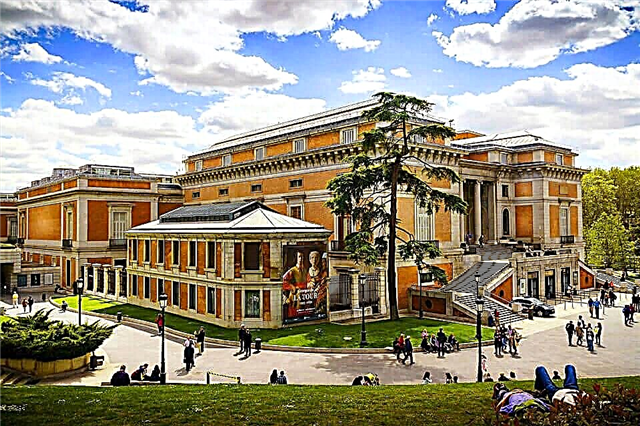
The Museum of Fine Arts in Madrid, which is not inferior in popularity to the Parisian Louvre, was opened in 1819 and was named Prado Park, which previously housed a public exhibition. The official organizer of the institution is Queen Isabella of Bragana, but in fact the foundation of the Prado collection was laid by King Charles V. Collecting works of Spanish painting and sculpture, he bequeathed them to the society.
A rich collection of artistic masterpieces (8 thousand paintings, 400 sculptures) of famous European creators made the Prado Museum an unusually popular object. Despite the impressive size of the museum building, only 2 thousand canvases are exhibited at the same time. Here today you can see the immortal creations of the Spanish classics of painting of the 17-19th century: Velazquez, Zurbaran, Goya, El Greco, etc.
The collection of Goya's works is especially extensive - 30 canvases of the extraordinary painter reflect all periods of his unique work. Almost all European schools of art are represented in the canvases of Raphael, Botticelli, Titian, Bosch, Durer, Cranach and many other talented painters. Among the magnificent examples of sculpture are the famous statues of Orestes and Pylada, an ancient Roman sculptor. A visit to the Prado is to enjoy the world of great art.
Royal Botanic Gardens
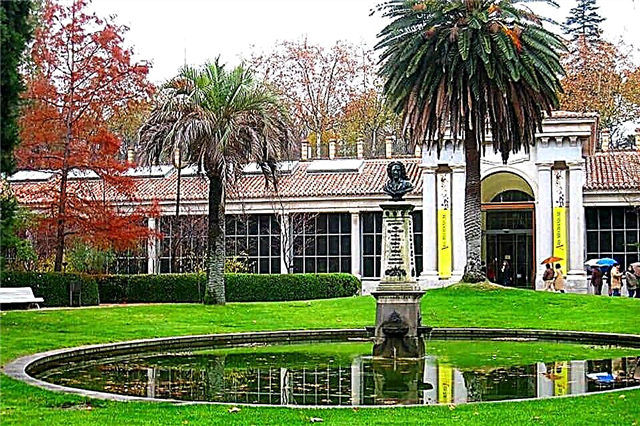
Next to the Prado Museum is an enchanting oasis of diverse flora - the Royal Botanic Gardens, which functions as a research center for CSIC. On 8 hectares, there are 3 thematic zones: plants of the American continent, the Pacific and European regions.
The modern garden was moved to the Paseo del Prado from the banks of the Manzanares River in 1774 and has been actively expanding all this time. Especially progressive changes took place in it in the 19th century, when greenhouse pavilions, a library, botanical classes appeared on the territory of the garden, scientific expeditions were organized around the world.
Today, the National Monument of Spain, the Royal Botanic Gardens, is one of the finest examples of its European counterparts. The entire area of the garden with 5 thousand different species of flora is divided into 4 terraces. The 1st lower terrace with a collection of decorative vegetation, fruit trees and rose gardens looks unusually picturesque. The 2nd lower terrace represents the evolutionary series of plants, from the most primitive to highly developed species.
On the highest Upper Terrace, which consists of 25 sectors, there is a park, a pond, a greenhouse with a rich collection of various plants, and an exhibition pavilion. Among the lush greenery, there is a gazebo with a bust of Karl Linnaeus, the greatest explorer and naturalist. An additional terrace presents unusual exotic collections of woody and herbaceous flora.
Toledo bridge
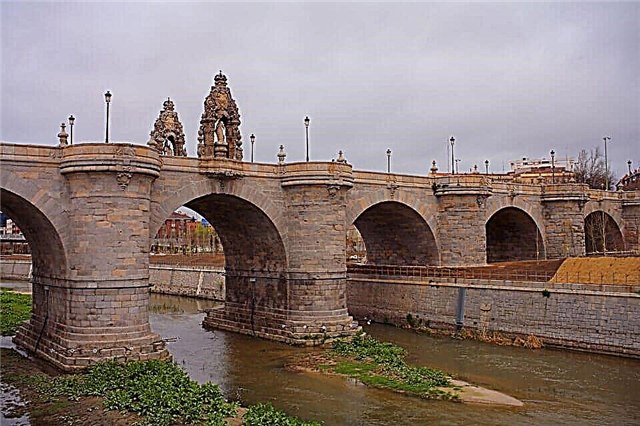
To call this most grandiose crossing structure simply a bridge is unfair. The magnificent urban development object symbolizes granite power, architectural grace and splendor of the Baroque, reliable durability. The Toledo Bridge over the Manzanares River was built in the 18th century. (1718-32) instead of the former ferry destroyed by the flood. Architect de Ribera designed a 9-arch bridge capable of withstanding flooding of any force. The mighty stone pillars between the arches are lined with monumental granite blocks.
The sides of each support are rounded in the form of a giant column, allowing the water to smoothly bend around them. Until 1952, the 4.95 m wide bridge was used for pedestrian transport, but after a tram accident that killed 15 people, Toledo became a pedestrian crossing. Today it is a favorite walking place for tourists and Madrid residents.
People come here to enjoy the surrounding views of the city and the baroque decorations of the bridge itself. In its central part, on both sides, there are statues of St. Isidore and Maria Torribia - examples of baroque sculpture art. On the ground part around the bridge, beautiful lawns and flower beds are laid out, pleasing to the eye.
Gate of Toledo
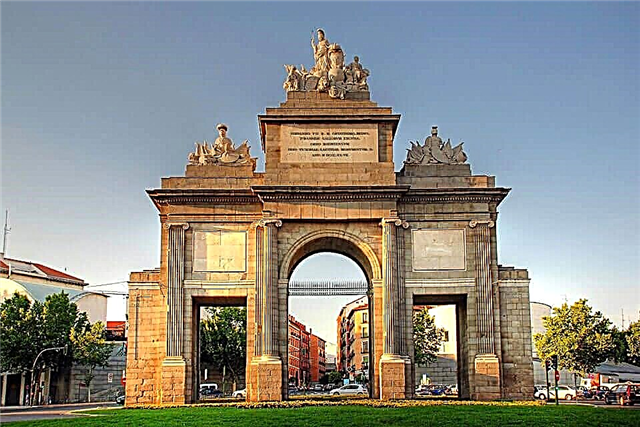
Near the main Cathedral of the city, there is a gray granite monument - the Toledo Gate. The majestic building was erected in the 2nd decade of the 18th century. (1817-27) on the site of the old fortress gate of the 15th century, leading to the city of Toledo. The neo-Romanesque monument is dedicated to King Ferdinand VII, who expelled the French from Madrid. It was designed by Antonio Aguado from granite and limestone quarried in the vicinity of Malaga. The Toledo gate consists of 3 arches - a semicircular central one and rectangular side arches.
The span of the central arch is decorated with Ionic semi-columns and pilasters. From the city side, the top of the arch is crowned with the coat of arms of Madrid, supported by angels. The outer side of the gate is pompously decorated with sculptural images. Above the main arch is a sculptural composition that symbolizes the power of Spain on the globe. An inscription glorifying Ferdinand VII is engraved below. Above the side arches are images of war trophies. On both sides, the monument is surrounded by picturesque lawns.
Las Vistillas Gardens
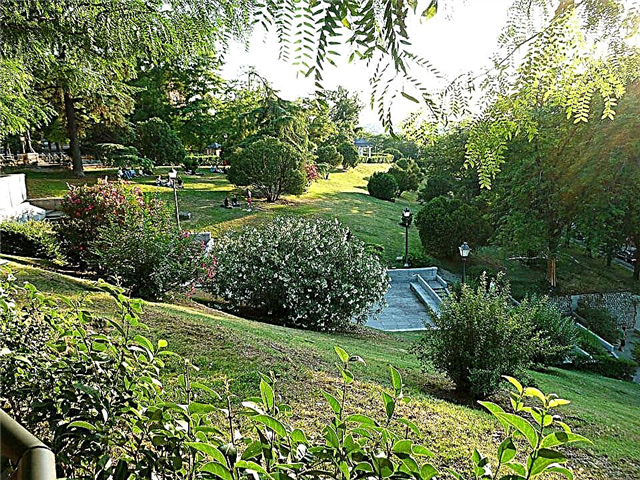
A charming green area in the oldest residential area of Madrid invites you to take a leisurely stroll amid velvet lawns, gazebos and a variety of trees. Many people come here to go up to the observation deck - a terrace equipped in one of the local cafes.
While quenching your thirst with cool drinks, you can enjoy the breathtaking views towards the Sierra de Guadarrama. During the civil war, the gardens were shelled by nationalists, and they were answered by Republicans from the bunker. A peculiar monument associated with death - the viaduct, built in place of the old bridge in 1942, is known as the site of suicides jumping from it. Therefore, in 1990, the authorities fenced it off with a plastic fence, slightly obstructing the view.
The construction of the viaduct was dictated by the need for more convenient movement of citizens across the tributary of the river. Manzanares. Before his appearance, people had to be transported to the other side by boats. If you have time, it is worth walking along the street. Segovia up south to see the Moorish Quarter, reminiscent of the city of Medina.
Plaza Mayor
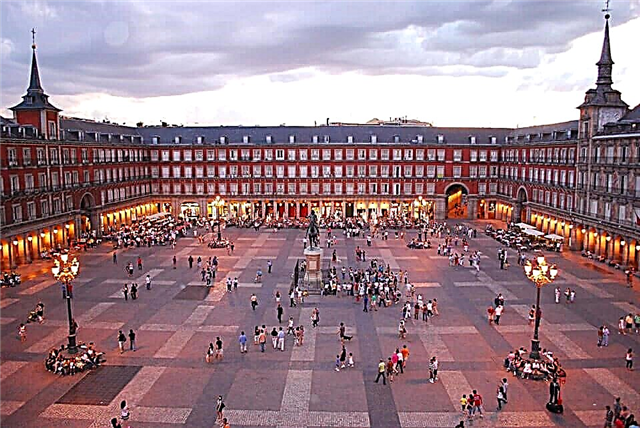
It is unforgivable not to visit a truly historical place in Madrid, shrouded in the flair of the events of past eras - Plaza Mayor. 2017 became a jubilee year for the square - it turned 4 centuries old. In the 15th century. it was the outskirts of the city, where there was a brisk trade in food and goods - a spontaneous market. Up to the 16th century. it was forbidden to erect any buildings here.
In the 16th century, a grandiose building with 377 balconies, 114 arch-entrances and 76 dormer windows was built on the square along its perimeter. Casa de la Panaderia - House-Bakery. In the terrible time of the Spanish Inquisition, cruel executions of heretics were carried out on the square. Later, the executions were moved to Barley (Cevada) Square, and returned during the years of French domination.
Major fires of the 17th century led to changes in the construction of the Bakery House. And after the fire in 1790, the 5-storey building became 3-storey. All the notorious balconies face the 4 cardinal points, which allowed them to serve as concert venues during the Christmas Festival of Multi-Genre Music (2017). On Christmas Eve, a festive fair is organized on the Plaza Mayor, colorful tents are erected selling various souvenirs.
El Rastro Market
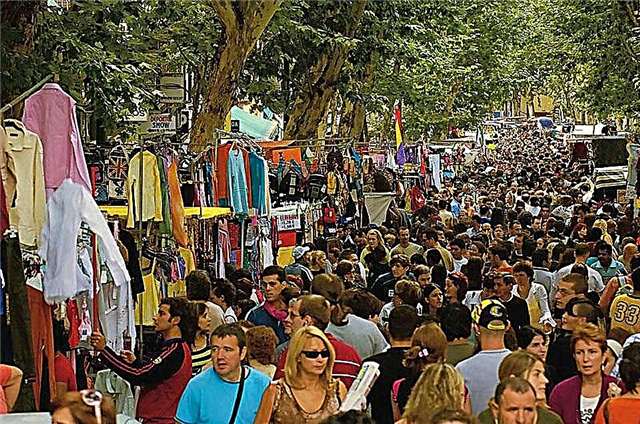
The oldest Spanish flea market, known throughout Europe, got its name El Rastro from the bloody footprints, when the skins of slaughtered animals were taken from the slaughterhouses to manufacture. It was in this place that leather production was based here in the Middle Ages. Today, it is a Sunday open-air flea market selling "sundries" and genuine rarities.
Tourists and townspeople are attracted here by the special Spanish flavor, cheerful atmosphere, the desire to acquire the cherished little thing. Cheerful music sounds, crowds of people look into the tents, hoping to find something extraordinary. In different places of the market, conditionally divided into thematic ones, everything related to a person's life and everyday life is sold.
Poultry, other animals, pet accessories with an interesting history. The sections of the streets have been turned into a continuous flea market: there is a street for artists, moviegoers, collectors of various stripes, and connoisseurs of antiques. But, as at any flea market, where there is a different audience, you need to be careful.
San Miguel Market
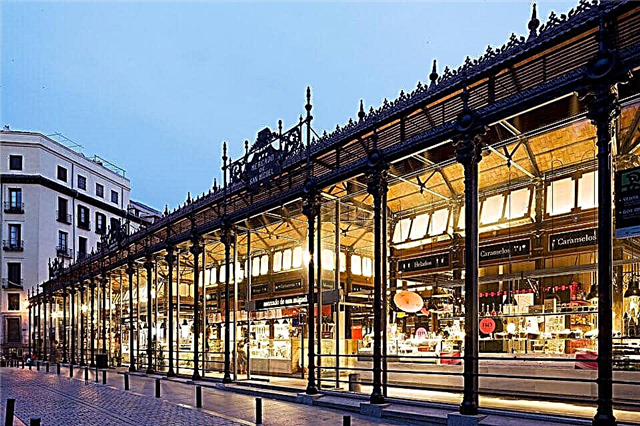
Organized at the beginning of the 19th century. on the site of the burnt church of San Miguel, the market of the same name is now one of the most popular places in the city. This is not just a market where you can buy any gastronomic product, but an object of entertainment and recreation. The recently renovated pavilion under a metal frame and glass inside looks very picturesque. All stalls are decorated with ceramic patterns, gas lamps are installed, counters are decorated in the form of tapas bars.
Basically, San Miguel is a gastronomic paradise with an international range of products to suit all tastes. Fresh oysters from France, black and red caviar from Russia, octopuses from Galicia, cod from Finland - the choice is not limited. Here you can buy freshly baked bread, cheeses of different varieties, seafood, any meat, vegetables and exotic fruits. The pavilion is conventionally divided into 3 sectors. The first one sells bread, all kinds of pastries, desserts.
Here you can, for example, have a barraquito coffee with churros or croissants. Seafood reigns in zone 2: scallops, octopuses, shrimps, crabs are served fried, boiled, raw. 3rd tapas sector, where they serve traditional Spanish food: cheeses, olives, pintxos, paella. Restaurants are located on the 2nd floor. In addition to the trading platform, San Miguel serves as a venue for concerts, fairs, presentations, training courses.
Almudena Cathedral
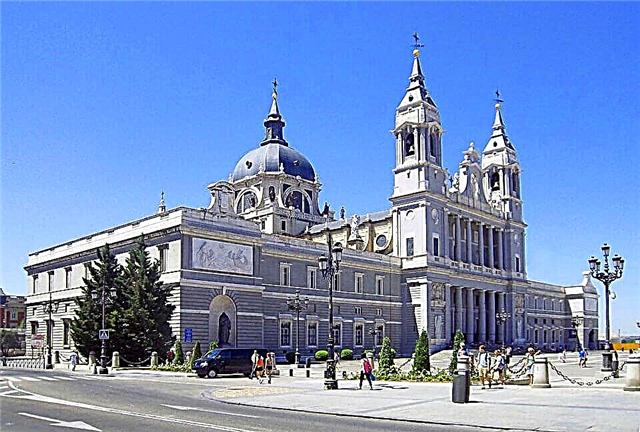
A magnificent neoclassical building next to the Royal Palace cannot fail to attract attention with the graceful beauty of its facades. Tourists always crowd in front of him. Although it is not an ancient site, it is surrounded by interesting history and legends. The construction of the Almudena Cathedral began in 1884 at the behest of King Alfonso VII, who planned to bury his wife Maria of Orleans, who died of tuberculosis, within its walls. According to legend, the statue of Our Lady of Almudena was delivered to Madrid in the 1st century. the apostle James.
But it had to be hidden from the Arabs who conquered Spain. The statue was allegedly found only in the 11th century. after the expulsion of the conquerors. The legendary sculpture (not the 1st century, but the 16th) is today kept in the cathedral. Maria Almudena is the patron saint of Madrid. The cathedral in her honor took a very long time to build, only in 1993 it was consecrated by Pope John Paul II, whose statue was installed in front of the temple. In the same year, the cathedral was opened to the public.
On the entrance gate of the temple, decorated with bas-reliefs, scenes of biblical subjects are depicted. Inside, the room is flooded with light with multicolored reflections pouring through large stained glass windows. An impressive green marble altar in the Orthodox style. The local museum displays rare icons and other church relics. Through the museum, you can climb to the observation deck located on the rooftop around the main dome to see a stunning panorama of the city.
Royal Palace
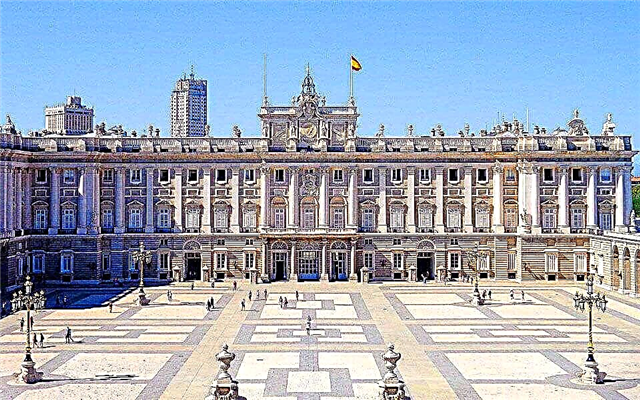
It is unforgivable to visit Madrid and not see its Royal Palace. An unusually beautiful architectural masterpiece is the largest of all European palaces existing today. It was built for 26 years (1738-64) for Charles III according to the project of the famous Italian architects Sabatini and Sacchetti. Nowadays, the palace plays the role of a museum and a place for special events. It is adjacent to the Campo del Moro Park, which houses the Museum of the Carriages.
The palace building, made in the Italian Baroque style, is striking in its large-scale volume - it has 3,500 rooms. The facades of the palace are faced with granite slabs, the decoration elements are made of white marble and Colmenar stone, which makes the building look light and festive. The interior decoration, considered the most beautiful in Europe, is an emotional shock.
Amazing frescoes by the best European painters, exquisite crystal chandeliers, chic tapestries, Rococo and Empire furniture, collections of weapons, Stradivarius violins are admirable. The Royal Palace is one of the best museums in Madrid.
El Teleferico Madrid cable car
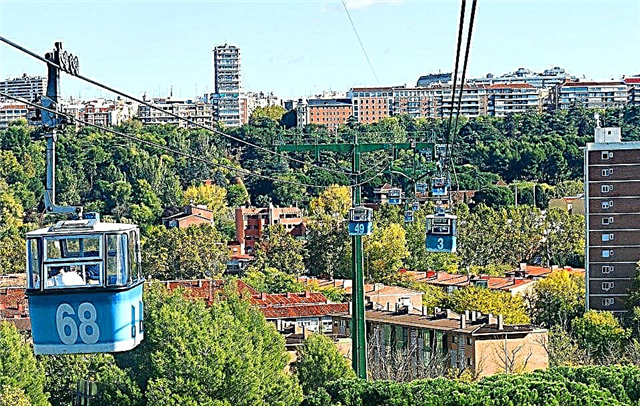
Experience the thrill of flying over the Manzanares River and Casa de Campo Park on the Teleferico cable car ride. It starts on st. Paseo del Pintoro Rosales and stretches for 2.5 km. 80 5-seater cable car cabins fly this distance in 11 minutes, during which you can see iconic landmarks: Spanish Square, Egyptian Temple, Royal Palace, Almudena Cathedral, etc.
Below is a picturesque view of the Casa de Campo Park, the largest park in the city. The cable car is a great way to get to the park, where there is a zoo, attractions, picnic areas. The maximum flight altitude is 40 m. Teleferico operates daily from April to September, from October to March - only on Saturday and Sunday, from 11.00 to 18.00. Due to strong winds, the funicular is stopped.
Temple Debod
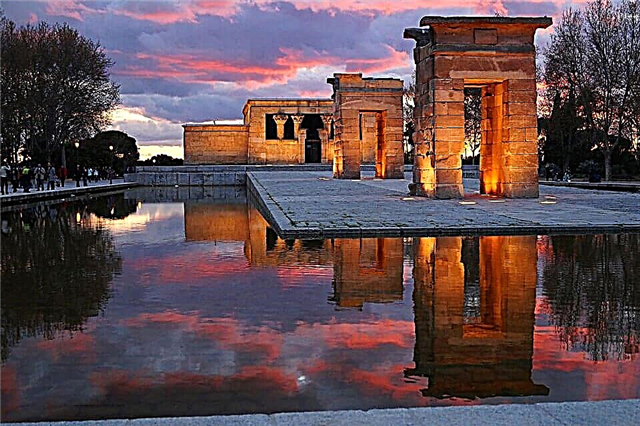
Having visited a unique structure, radically different in appearance from other religious monuments, the Debod Temple, you will seem to find yourself in Ancient Egypt. It was there in the 4th century. BC NS. there was this structure. At first it was a small chapel, later supplemented by other buildings. Crowds of pilgrims came to the temple, worshiping the ancient statue of the goddess Isis. The grateful people of Egypt presented this temple to Spain as a token of gratitude for its participation in the preservation of the temples of Ancient Nubia from flooding.
In 1968, Debod was disassembled in parts and taken by ships to Madrid, installed in the West Park. In 1972, the ceremonial opening of a religious rarity, a monument of classical architecture of Ancient Egypt, took place. The main object of the temple is the best preserved chapel. Outside, it is decorated with bas-reliefs, and inside - hieroglyphs on the walls, paintings depicting various ritual subjects. Debod's archives contain photos and documents illustrating the history of the temple.
Arch of Victory
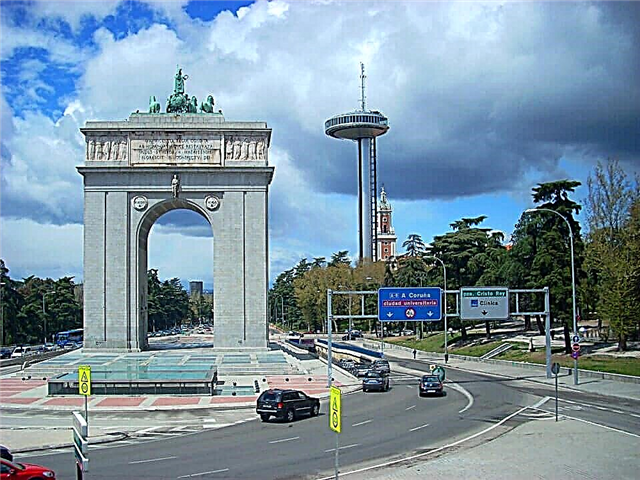
The architectural symbol of the triumph of the national army over the Republicans in the Civil War - the Arch of Victory was erected in the Plaza de la Moncloa. It was built by the order of dictator Franco in the 50s of the 20th century. Otherwise, the building is called the Gate of Moncloa, not wanting to associate it with the memory of the bloody dictator. Architects Otero and Sanfeliu worked on the project of the 40-meter-high monument.
The top of the Arch is crowned with a sculptural composition in the form of four horses harnessed to a carriage. They are ruled by the goddess Minerva. The facades are carved with inscriptions in Latin about the victory, about the restoration of the university town, which was destroyed during the military conflict. Inside the building there is a room with a model of the university and the originals of the plans for the construction of the Arch. The arch is currently closed to the public and is viewed from a distance.
Promenade of Manzanares
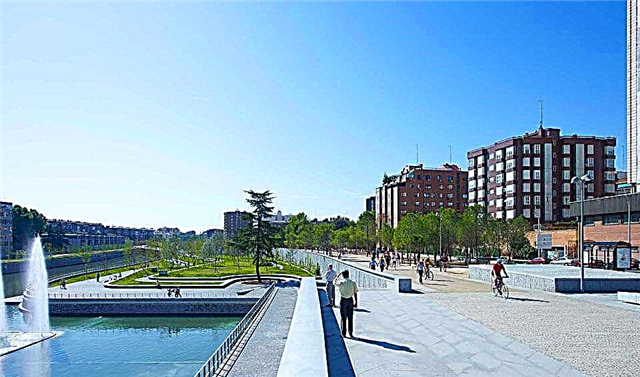
The result of the implementation of the project for the arrangement of the river's coastal zone - the Manzanares embankment - a wonderful place in the Spanish capital. On the territory of 650 hectares, a grandiose reconstruction was carried out, green areas were laid out, new pedestrian bridges were built. Each of them is an attractive architectural object. The stainless steel Arganzuela Bridge is one of the finest examples of a pedestrian crossing. Some of them are decorated with mosaics.
Along the river there are parks with bicycle paths, fruit and ornamental gardens, dozens of playgrounds and sports grounds. They carried out hydraulic engineering works, cleared the river bed, erected dams, reservoirs for rainwater to replenish the river bed with it. The whole complex was named "Madrid Rio", opened in 2011. But work on the further improvement of its territory continues to improve the ecology and more convenience for the townspeople.
How to get from the airport to the center:
If a plane from Moscow to Barakhan airport arrives at terminal T4S, follow the Exit signs to go to the electric train running to terminal T4. If you arrived at terminal T1, you don't need to go anywhere. 8 metro lines are connected to the airport. From terminals T1, T2, T3, T4 you can reach Nuevos Ministerios in 15 minutes and from there you change to trains on lines 6 and 10, leading to the historic city center. The metro operates from 06.05 - 02.00.
At the same terminals there are express bus stops that run every 15-20 minutes during the day, and 35-45 minutes at night. Travel time - 35-40 minutes, ticket - 5 €. Apart from this, there are many buses passing by. If you don't need to save money, you can order a taxi (average price 40-50 €).

